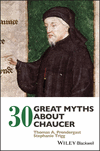CHAUCER IS OBSCENE
Summary
Until relatively recently, the creation of obscenity as a crime or as an offense to public morals was seen to be synonymous with the rise of modernity. The “rude” Middle Ages was viewed as a time when bawdiness was accepted and accommodated. What this shameful, filthy obscenity might consist of is difficult to determine, but Isidore of Seville suggests that it may relate to different kinds of “love.” The love of a wife is just and the love of children pious, but the love of a prostitute is obscene. In one sense Chaucer generates obscenity by creating a fictional situation where that which should remain hidden is made public. George Shuffleton argues that Chaucer is obscene (though not pornographic), and this is precisely why he remains in the literary canon: “generations of students are taught how to be high-minded about obscenity, how to distinguish between a dirty joke and a respectable tale.



